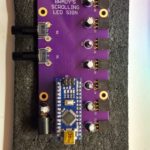Writing More about Writing More Arduino Articles
Since my main theme for 2020 is Writing, I’m assigning myself a much larger number of writing jobs. In fact, just telling you this is helping me achieve one of my writing goals! Approaching writing as a project can get a bit meta. I’m still happy to be writing about writing, and looking forward to writing about Arduino.
Some Arduino Project Updates!
This week I have not one but two (!) projects that involve writing more about Arduino. The first project is about Brady’s Scrolling LED Sign, based on the Arduino Nano. The second project is a more in-depth, hands-on article about the new RISC-V chips from GigaDevice.
Scrolling LED Sign – A Good Application for an Arduino

I have been working on the Scrolling LED Sign project for the last few months, and I’m at the point where it seems prudent to share some of the background and details of this project. The original project by Josh Levine also used an Arduino UNO, but Josh suggested that the Arduino Pro Mini model would also work at a lower cost.
To find out how we ended up using the Arduino Nano, you’ll just have to read the project post.
RISC-V & Arduino… Wait, what?
My second writing project (Hands on With RISC-V, Part 1 – An Introduction) might be a bit of a head-scratcher. What has this cutting-edge technology have to do with Arduino? Generally speaking, I consider myself “an Arduino cheerleader, but not an Arduino shareholder”. I still firmly believe that Arduino has its place in the Grand Order of Things. Arduino is useful because it’s easy. Projects get up and running quickly and people build their enthusiasm and fuel their future investigations. However, a drawback of Arduino is that it’s very simple, and it’s this simplicity that I find limiting.
Does this mean that I am somehow “anti-Arduino”? Not at all. That would be like saying I was “anti-ketchup”, because it’s good with some things and not so much with others. As I said, I think Arduino has its place.
I plan to use the Arduino IDE in a hands-on investigation of the Sipeed Longan Nano. It’s a small and inexpensive development board from Seeed Studios which uses a new RISC-V chip from GigaDevice (part #GD32VF103CBT6). There seems to be a great deal of interest in these new chips. This makes me want to show you some of the ways I’ve been able to bend it to my will.
Stay tuned for more updates – see you in the future!